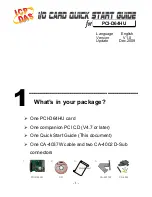
ENGINEERING MANUAL OF AUTOMATIC CONTROL
CONTROL FUNDAMENTALS
25
PROPORTIONAL-INTEGRAL-DERIVATIVE (PID)
CONTROL
Proportional-integral-derivative (PID) control adds the
derivative function to PI control. The derivative function
opposes any change and is proportional to the rate of change.
The more quickly the control point changes, the more corrective
action the derivative function provides.
If the control point moves away from the setpoint, the derivative
function outputs a corrective action to bring the control point back
more quickly than through integral action alone. If the control
point moves toward the setpoint, the derivative function reduces
the corrective action to slow down the approach to setpoint, which
reduces the possibility of overshoot.
The rate time setting determines the effect of derivative action.
The proper setting depends on the time constants of the system
being controlled.
The derivative portion of PID control is expressed in the
following formula. Note that only a change in the magnitude
of the deviation can affect the output signal.
V = KT
D
Where:
V = output signal
K = proportionality constant (gain)
T
D
= rate time (time interval by which the
derivative advances the effect of
proportional action)
KT
D
= rate gain constant
dE/dt = derivative of the deviation with respect to
time (error signal rate of change)
The complete mathematical expression for PID control
becomes:
V = KE +
∫
Edt + KT
D
+ M
Where:
V = output signal
K = proportionality constant (gain)
E = deviation (control point - setpoint)
T
1
= reset time
K/T
1
= reset gain
dt
= differential of time (increment in time)
T
D
= rate time (time interval by which the
derivative advances the effect of
proportional action)
KT
D
= rate gain constant
dE/dt = derivative of the deviation with respect to
time (error signal rate of change)
M = value of the output when the deviation
is zero
SETPOINT
T1
T2
T3
T4
T5
T6
C2099
CONTROL
POINT
OFFSET
TIME
SETPOINT
T1
T2
T3
T4
T5
T6
C2100
CONTROL
POINT
OFFSET
TIME
SETPOINT
T1
T2
T3
T4
T5
T6
C2501
TIME
OFFSET
The graphs in Figures 38, 39, and 40 show the effects of all
three modes on the controlled variable at system start-up. With
proportional control (Fig. 38), the output is a function of the
deviation of the controlled variable from the setpoint. As the
control point stabilizes, offset occurs. With the addition of
integral control (Fig. 39), the control point returns to setpoint
over a period of time with some degree of overshoot. The
significant difference is the elimination of offset after the system
has stabilized. Figure 40 shows that adding the derivative
element reduces overshoot and decreases response time.
dt
dE
dt
dE
K
T
1
Proportional Integral Derivative
Fig. 38. Proportional Control.
Fig. 39. Proportional-Integral Control.
Fig. 40. Proportional-Integral-Derivative Control.
ENHANCED PROPORTIONAL-INTEGRAL-
DERIVATIVE (EPID) CONTROL
The startup overshoot, or undershoot in some applications,
noted in Figures 38, 39, and 40 is attributable to the very large
error often present at system startup. Microprocessor-based PID
startup performance may be greatly enhanced by exterior error
management appendages available with enhanced proportional-
integral-derivative (EPID) control. Two basic EPID functions
are start value and error ramp time.
Summary of Contents for AUTOMATIC CONTROL SI Edition
Page 1: ...AUTOMATIC CONTROL for ENGINEERING MANUAL of COMMERCIAL BUILDINGS SI Edition ...
Page 4: ...ENGINEERING MANUAL OF AUTOMATIC CONTROL iv ...
Page 6: ...ENGINEERING MANUAL OF AUTOMATIC CONTROL vi ...
Page 46: ...ENGINEERING MANUAL OF AUTOMATIC CONTROL CONTROL FUNDAMENTALS 36 ...
Page 66: ...ENGINEERING MANUAL OF AUTOMATIC CONTROL PSYCHROMETRIC CHART FUNDAMENTALS 56 ...
Page 128: ...ENGINEERING MANUAL OF AUTOMATIC CONTROL ELECTRIC CONTROL FUNDAMENTALS 118 ...
Page 158: ...MICROPROCESSOR BASED DDC FUNDAMENTALS 148 ENGINEERING MANUAL OF AUTOMATIC CONTROL ...
Page 208: ...ENGINEERING MANUAL OF AUTOMATIC CONTROL BUILDING MANAGEMENT SYSTEM FUNDAMENTALS 198 ...
Page 493: ...INDEX ENGINEERING MANUAL OF AUTOMATIC CONTROL 483 INDEX ...
Page 506: ...ENGINEERING MANUAL OF AUTOMATIC CONTROL INDEX 496 NOTES ...
Page 507: ...INDEX ENGINEERING MANUAL OF AUTOMATIC CONTROL 497 NOTES ...
Page 508: ...ENGINEERING MANUAL OF AUTOMATIC CONTROL INDEX 498 NOTES ...
Page 509: ...INDEX ENGINEERING MANUAL OF AUTOMATIC CONTROL 499 NOTES ...
Page 510: ...ENGINEERING MANUAL OF AUTOMATIC CONTROL INDEX 500 NOTES ...
Page 511: ...INDEX ENGINEERING MANUAL OF AUTOMATIC CONTROL 501 NOTES ...
Page 512: ...ENGINEERING MANUAL OF AUTOMATIC CONTROL INDEX 502 NOTES ...
















































